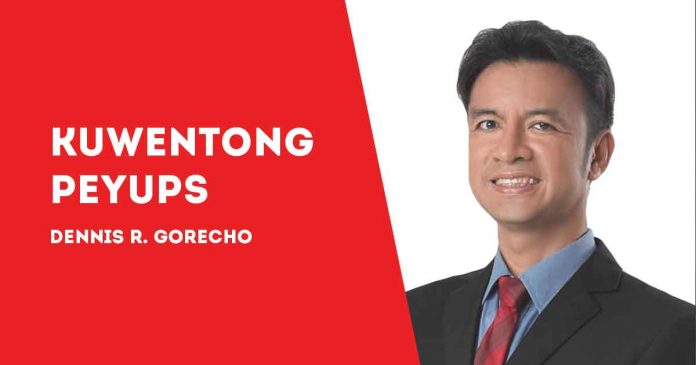
IT WAS former Education Secretary Onofre “OD” Corpuz who told me that one of the pioneers in the establishment of banks in the Philippines is a namesake, Damasco Gorricho.
He said my surname is perhaps a permutation of “Gorricho” and it originated from Bohol. His statement encouraged me to do a deeper research on my family tree.
Corpuz was the 13th president of the University of the Philippines (UP) from 1975 to 1979. He was a Filipino academic, economist and historian who was also my professor in Economic History at the UP School of Economics in the late 1980s.
His name is now part of the list of 21 UP presidents since the state university was established where 19 are Filipinos and two are Americans.
Based on Republic Act 9500 or the UP Charter of 2008, the UP president serves as the university’s chief academic officer, head of the faculty and chief executive officer for a fixed term of six years.
The President is expected to pursue goals stated in the UP Charter and pursue the Vision-Mission he pledged to the community.
Two Americans served as UP Presidents: Murray Bartlett (1st) from 1911 until 1915 and Guy Potter Benton (3rd) from 1921 until 1925.
Ignacio Villamor (2nd, 1915 to 1921) and Jorge Bocobo (5th, 1934 to 1939) later became Supreme Court justices after their term.
Rafael Palma (4th, 1925 to 1934) and Edgardo Angara (15th, 1981 to 1987) became senators.
Agriculturist Bienvenido Gonzalez was the only president who was appointed twice: 6th in 1939 to 1943 and 8th in 1945 to 1951. At 46 years old, he was the youngest ever to be named UP president.
Antonio Sison served as the 7th president during the wartime years 1943 to 1945.
Two engineers became presidents: Vidal Tan (8th, 1951 to 1956) and Emanuel V. Soriano (14th, 1979 to 1981).
Statistician Enrique Virata (9th) served from 1956 to 1958.
Vicente Sinco (10th, 1958 to 1962) and Danilo Concepción (21st, 2017 to 2022) were former deans of the UP College of Law.
Carlos Romulo Sr. (11th, 1962 to 1968) and Salvador Lopez (12th, 1969 to 1975) are also known as Filipino diplomats, statesmen, journalists, and authors.
It was during Lopez’s presidency that UP students were politically radicalized, launching mass protests against the Marcos regime right from the so-called “First Quarter Storm” in 1970 to the “Diliman commune” in 1971.
My stay in UP was under two presidents: José Abueva (16th, 1987 to 1993) and Emil Javier (17th, 1993 to 1999).
It was in Abueva’s term when I finished B.S. Economics in 1991. He introduced the Socialized Tuition Fee Assistance Program (STFAP) in 1987. He also institutionalized a Filipino language policy within the university.
It was in Javier’s term when I finished Bachelors of Laws in 1998. He is a Filipino plant geneticist and agronomist.
Francisco Nemenzo Jr. (18th, 1999 to 2005) is a Filipino political scientist, educator, and activist. His son, Fidel, is a mathematician and incumbent chancellor of UP Diliman who is also a current nominee for UP President.
Emerlinda Roman (19th, 2005 to 2011) is the first woman President.
Alfredo Pascual (20th, 2011 to 2017) is a Filipino international development banker and finance expert.
Danilo Concepción’s six-year term as the 21st President started in February 2017 and will end on Feb. 9, 2023. He earlier served as Dean of the UP College of Law (2011-2017).
The next UP president will be appointed by the 11-member Board of Regents.
The six official candidates for the next UP President who will succeed Concepcion are Catanduanes State University president Patrick Alain Azanza, former 1-Edukasyon party-list representative Salvador Belaro Jr., former faculty regent Angelo Jimenez, UP Diliman chancellor Fidel Nemenzo, former UP Diliman vice chancellor for research and development Benito Pacheco and former UP Los Baños chancellor Fernando Sanchez Jr.
During the public forum on the search, Nemenzo stressed that his vision for UP is centered on three points: making an agile UP, a smart UP, and a high-impact UP.
An agile UP will allow UP to pivot and respond quickly to disruptions through the use of newest academic research programs which are fostered in an environment of critical thinking and democratic culture.
He believes that building a smart UP means accelerating digital transformation while addressing inequalities in access to technology that are responsible for the so- called digital divide.
Nemenzo also stressed that being a high-impact university meant leveraging the diversity of critical knowledge produced across the UP system for UP to take a leadership role in issues of national importance such as food security, health, culture, and the arts.
The next president must lead the university that molded us to fight for the causes we believe in; trained us for the skills we need to communicate ideas; and rally others to effect changes in society.
***
“Peyups” is the moniker of the University of the Philippines.
***
Atty. Dennis R. Gorecho heads the seafarers’ division of the Sapalo Velez Bundang Bulilan law offices. For comments, e-mail info@sapalovelez.com, or call 0917-5025808 or 0908-8665786./PN

